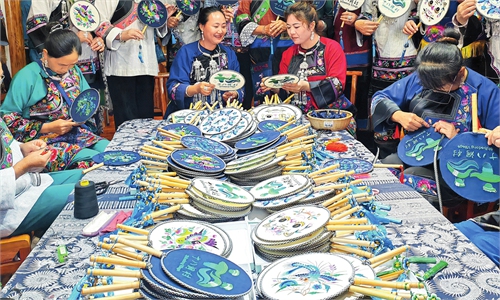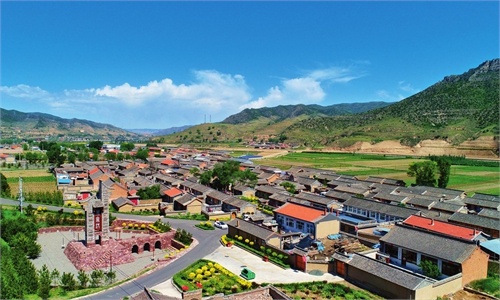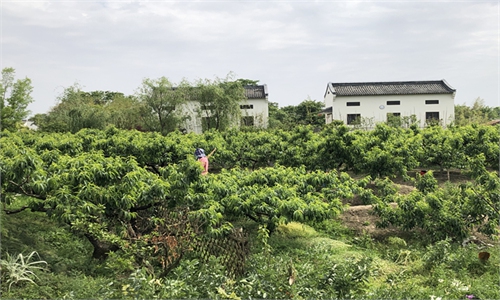China Rural Revitalization magazine has published a series of articles on the rapid development and transformation of rural China. The articles reflect the arduous efforts of rural revitalization across the country, which is an important and genuine solution to China's rural economic development. In the future, articles selected from this
series will be published.
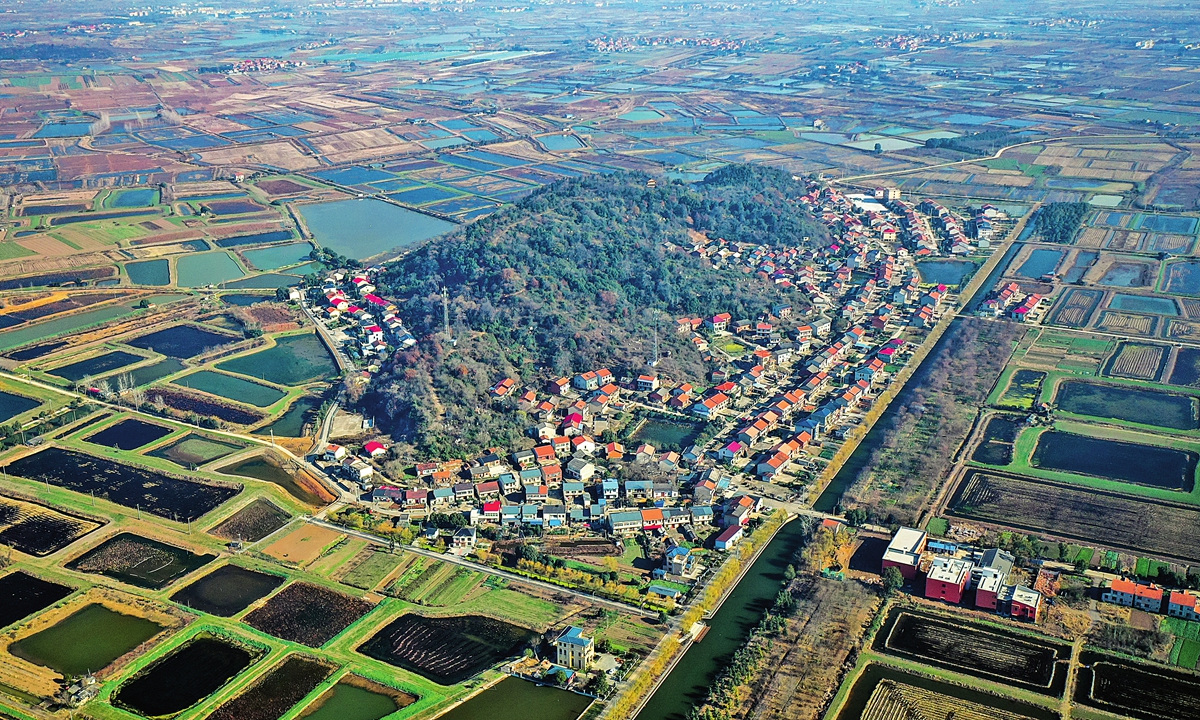
An aerial view of Dongshan village Photo: Courtesy of China Rural Revitalization magazine
Located in Central China, Hubei Province features a landscape of crisscrossing mountains and rivers, including the expansive Jianghan Plain. The province, known as the "Land of Fish and Rice" in the country, however, was burdened with poverty in history.
Helped by the government's initiatives to solidify poverty-alleviation gains and ramping up rural economic revitalization, Dongshan village and Xujiachong village in Hubei have applied innovation methods in farming and local industry management, which has enhanced rural quality of life for many residents.
Modern agriculture
Chinese President Xi Jinping on November 6, 2024, urged Central China's Hubei Province to forge ahead with the high-quality development of the Yangtze River Economic Belt, speed up efforts to build itself into a strategic fulcrum for the rise of the country's central region, and write its own chapter in Chinese modernization.
Xi, also general secretary of the Communist Party of China (CPC) Central Committee and chairman of the Central Military Commission, made the remarks during an inspection tour in the province from November 4 to 6.
To develop modern agriculture and build a strong agricultural sector, continuous advancement of science and technology is a must, and a good job must be done to make it possible for scientific and technological progress to help advance agricultural modernization, Xi said on November 5 during his inspection tour to Jiayu county in Xianning city, where he visited a vegetable farm in Panjiawan township.
Chen Kaiyan, 58 years old, is among the first batch of the residents in Dongshan village to lease land for farming, initially focusing on traditional crops such as rice, lotus and cotton. Following local officials' introduction of the "shrimp-rice co-culture" model, Chen participated in a study program and converted his 43 acres of land to the shrimp-rice farming model.
Chen has benefited from this innovative farming model. He said that usage of new technologies in shrimp selection and the use of drones for sowing rice and spraying pesticides ensure that he stays at the forefront of modern agriculture.
Over the past decade, Dongshan village has developed from a traditional village into a modern rural community, integrating shrimp-rice farming, aquaculture, lotus production, rural tourism and educational programs.
Growing vitality
Guiding the villagers to adopt new and efficient ways of farming and production has been essential to the prosperity of Xujiachong village.
In 2018, in response to local cooperative's need for farming talent, Wang Huaxin quit his job in a hospital in Yichang city, in western Hubei, and was encouraged by her father to help run the family cooperative. Also, Xujiachong village has provided support for Wang's family, such as organizing multiple training programs for them.
"I have traveled to all major tea-producing regions across China, such as the Wuyi Mountain in Fujian Province, Hangzhou city in Zhejiang Province and Huangshan Mountain in Anhui Province, as well as other tea regions in Sichuan and Shaanxi provinces," Wang said. "As a result, I have learned a lot, regarding tea planting, production and marketing."
With her broadened knowledge, Wang registered a company to produce high-quality tea and started a live-streaming business too.
"When I first joined the cooperative, annual sales were around 10 million yuan ($1.38 million). Now the sales have tripled to more than 30 million yuan," said Wang, adding that his tea company can now help increase the income of more than 600 rural households in the village.
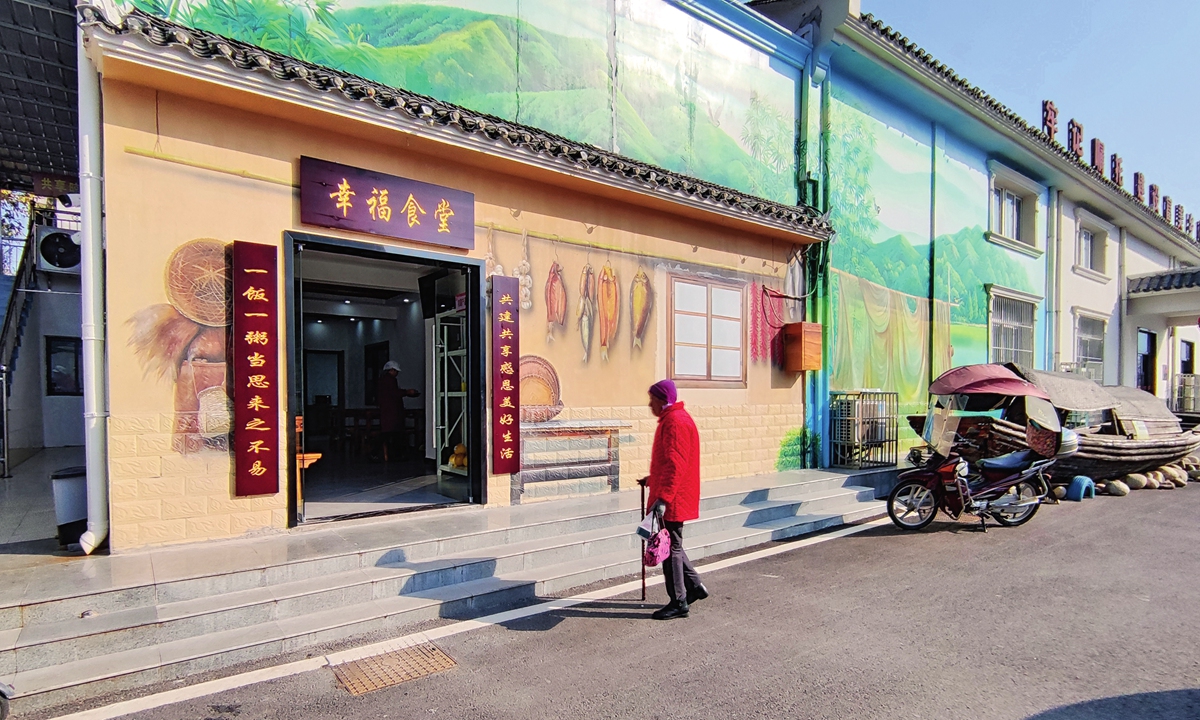
An elderly caring restaurant in the Xujiachong village Photo: Courtesy of China Rural Revitalization magazine
Renewed cultural heritage
On the morning of November 6, Xi listened to work reports from the CPC Hubei Provincial Committee and the Hubei provincial government.
Highlighting Hubei's profound historical and cultural heritage and rich revolutionary resources, Xi urged the province to proactively strengthen the conservation of cultural resources and promote innovative development of the cultural sector.
Xie Rong, the Party Secretary of Xujiachong village in Hubei, is also a fifth-generation inheritor of "Qianhua Embroidery," a form of intangible cultural heritage.
As the local tourism industry flourished in 2012, Xie noticed the potential in transforming traditional crafts into an industry. She founded a traditional craft cooperative and later established a folklore culture company.
Over the past decade, Xie has continuously updated her embroidery designs as well as marketing strategy. From the initial production of sachets and insoles, now her business has expanded to cover more than 120 items across four categories - decorative, functional, ornamental, and hanging items.
Xie's business grew from a 200-square-meter workshop to become a 1,200-square-meter rural factory, with sales increasing 10-fold, expanding from retail and wholesale to online sales and brand cooperation.
Today, Xie's embroidery cooperative employs more than 100 women from the village, helping each of them increase annual income by approximately 20,000 to 50,000 yuan. The cooperative also set up a Qianhua embroidery training center, providing training service to nearly 800 local women, including six women who have become inheritors of that intangible cultural heritage.
